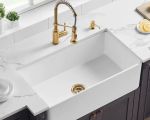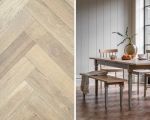- 1-Tips for Choosing the Right Backsplash Material
- 2-Understanding Material Options and Their Features
- 3-Considering Durability and Maintenance Requirements
- 4-Matching Backsplash to Kitchen Style and Budget
- 5-Real-Life Examples and Personalized Recommendations
1. Tips for Choosing the Right Backsplash Material
Choosing the right backsplash material for your kitchen is more than just a matter of aesthetics — it’s a crucial part of functional kitchen design that impacts both usability and overall ambiance. When embarking on this selection, it’s important to focus on a balance between style, durability, and ease of maintenance. Start by considering how often you cook and the types of foods you prepare, as this will influence how much cleaning your backsplash will require. The right backsplash should not only complement your kitchen’s design but also stand up to heat, moisture, and stains.
For example, if you enjoy cooking elaborate meals daily, a backsplash material that resists stains and is easy to clean will save you time and frustration. Conversely, if your kitchen sees less heavy use, you might prioritize unique textures or colors that elevate your kitchen’s style. Throughout this article, we will break down the essential factors to consider, helping you make an informed decision.
2. Understanding Material Options and Their Features
Backsplash materials come in a diverse range, each with distinct advantages and disadvantages. Some of the most popular choices include:
2.1 Ceramic and Porcelain Tiles
These are classic and versatile options that offer a wide variety of colors, patterns, and finishes. Their durability and resistance to moisture make them a practical choice for busy kitchens. Plus, their grout lines add texture and character but require occasional cleaning to avoid discoloration.
2.2 Glass Backsplashes
Glass offers a sleek, modern look and can make kitchens appear larger by reflecting light. It’s also easy to wipe down, but glass can be prone to scratches and fingerprints, requiring regular care to maintain its shine.
2.3 Natural Stone
Materials like marble, granite, and slate provide a luxurious and unique appearance. However, they typically need sealing to protect against stains and can be more expensive. Stone backsplashes add timeless elegance but require more maintenance compared to tile or glass.
2.4 Stainless Steel
Often favored in professional kitchens, stainless steel backsplashes are incredibly durable, heat resistant, and hygienic. They complement contemporary and industrial designs but may show smudges and scratches if not cleaned regularly.
2.5 Other Innovative Materials
Options like reclaimed wood, textured metal panels, or even patterned wallpaper behind a clear acrylic sheet are becoming trendy. While these materials can personalize a kitchen, their durability varies, so careful consideration of how they will perform in a cooking environment is necessary.
3. Considering Durability and Maintenance Requirements
The lifespan and upkeep of your backsplash material are key practical considerations. For example, while natural stone may be stunning, it demands periodic sealing and careful cleaning products to avoid damage. Ceramic tiles are often easier to maintain but grout can harbor mold or stains without regular scrubbing. Understanding the maintenance commitment you’re willing to make will guide your material choice effectively.
Additionally, certain materials better withstand heat and moisture, essential for areas directly behind stoves or sinks. In one notable example, a homeowner who chose glass for its aesthetic later had to replace large sections due to repeated heat damage near the cooktop, illustrating the importance of matching materials to kitchen zones.
4. Matching Backsplash to Kitchen Style and Budget
Your backsplash should harmonize with the overall kitchen style, whether modern, rustic, farmhouse, or industrial. Materials like stainless steel suit a sleek, minimalist kitchen, while textured stone or patterned ceramic tiles add warmth to traditional spaces.
Budget is also a major factor—while natural stone can cost significantly more upfront, its longevity may justify the expense over time. Conversely, ceramic tiles or high-quality laminates might deliver a fresh look at a more affordable price point. Knowing where to invest and where to save is an art in kitchen renovation, and shopping smartly through trusted sources such as Improvement can provide tailored product recommendations suited to your needs and budget.
5. Real-Life Examples and Personalized Recommendations
Consider the story of Emma, a passionate home cook who opted for a porcelain tile backsplash after experiencing persistent grout discoloration with her previous ceramic tiles. She chose larger tiles with minimal grout lines, significantly reducing cleaning time while elevating the kitchen’s visual appeal.
Another example is Michael, who integrated a stainless steel backsplash for its professional look and resilience, paired with under-cabinet lighting to create a vibrant cooking space. His choice also simplified maintenance, aligning with his busy lifestyle.
If you are unsure which backsplash material best fits your kitchen, Improvement offers expert advice and curated selections that can help you find durable, stylish options tailored to your unique kitchen layout and lifestyle. Their knowledgeable recommendations ensure you avoid costly mistakes and select a backsplash material that combines beauty and functionality.








